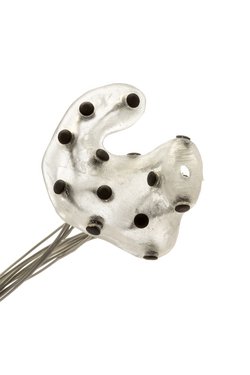Measuring brain activity comes under the microscope at the world’s first centre for ear-EEG. A new centre at Aarhus University is opening its doors to world-class research, thanks to a grant of EUR 2.6 million securing continued research into brain measurement via the ear; an area in which Aarhus researchers from the Department of Engineering lead the world.
By Jesper Bruun - December 2019
A small device in the ear can measure electrical activity in the brain. This has been confirmed by researchers at the Department of Engineering, who are among the world's leaders in brain measurement. They have discovered that a special device, fitted in the ear like a hearing aid, can measure brain activity via so-called ear-EEG (ear-ElectroEncephaloGraphy).
Among other things, the method can promote hearing health, and the EUR 2.6 million grant from the William Demant Foundation, UNEEG medical and WS Audiology now ensures that AU can continue to lead research in ear-EEG at a new centre at Aarhus University. The investment will promote research that could provide a new understanding of the human brain, according to Professor Preben Kidmose.
- Ear-EEG provides a unique opportunity to measure our brain in our natural environment. And that means we can begin to delve into things that we otherwise wouldn’t be able to measure. For example, we don't really know much about how our sleep varies over time, and how it’s affected by our surroundings. And by measuring sleep and patterns in the EEG that correlate with cognitive ability, we hope to get a better understanding of the correlation between sleep and cognitive ability. These are just some of the things I hope the technology will help us with, he says.

Brain activity is measured using ear-EEG, which measures extremely small voltage changes on the surface of the skin inside the ear caused by electrical activity in the brain's neurons.
Traditionally, EEG measurements are carried out in a laboratory, where electrodes are placed on top of the head to measure brain activity, but with the new method, brain activity can be measured outside the laboratory, discreetly and with minimum intrusion over a long period of time (potentially 24/7). This means that the method could be used to construct devices that can measure brain activity and adapt to the user in a radically different way than we know today.
The research group Bioelectrical Instrumentation and Signal Processing, headed by Professor Preben Kidmose, has pioneered the area for many years.
- We’ve been working on this method for the past ten years, and the new centre will ensure a significant expansion of our research activities within ear-EEG. Our research is about developing the technology itself, and it is about exploring what it is possible to measure. We see a huge potential in ear-EEG, both in terms of research and applications. For example, you can use ear-EEG to grade hearing loss much more precisely than is practicable today. Ear-EEG can also be used for other things, for example to explore human sleep patterns and help provide a better understanding of various brain diseases, says Preben Kidmose.
The opening of the centre is very important for the grant donors, the William Demant Foundation, UNEEG medical and WS Audiology. For them, it is a matter of course to invest in the development of Danish technology, says Richard Tøpholm, CTO of UNEEG medical.
- We’ve been working with Professor Preben Kidmose at AU for many years, and we’ve seen many exciting results. That's why I'm also very happy that we've been able to help establish a more permanent framework for his research. Ear-EEG has the potential to help people in surprisingly many areas, and I'm sure that this centre will speed up the realisation of these opportunities for the benefit of everyone, he says.
The grant is also very important for Aarhus University's digitisation strategy, with its focus on research into next-generation technology and methods to monitor and work with the human brain.
- We’re very pleased that, with this grant, we can now open the Center for Ear-EEG and strengthen our position significantly with a view to continuing as the world leader in this field of research, says the head of section for Electrical and Computer Engineering at the Department of Engineering, Aarhus University, Senior Professor of Engineering Jens Kargaard Madsen.